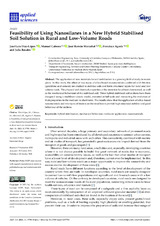Mostrar el registro sencillo del ítem
Feasibility of Using Nanosilanes in a New Hybrid Stabilised Soil Solution in Rural and Low-Volume Roads
| dc.contributor.author | Díaz-López, José Luis | |
| dc.contributor.author | Cabrera, Manuel | |
| dc.contributor.author | Marcobal, José Ramón | |
| dc.contributor.author | Agrela Sáinz, Francisco | |
| dc.contributor.author | Rosales, Julia | |
| dc.date.accessioned | 2021-10-20T12:23:36Z | |
| dc.date.available | 2021-10-20T12:23:36Z | |
| dc.date.issued | 2021 | |
| dc.identifier.uri | http://hdl.handle.net/10396/21908 | |
| dc.description.abstract | The application of new materials for soil stabilisation is a growing field of study in recent years. In this work, the effect of two types of silica-based nanomaterials combined with binders (quicklime and cement) are studied to stabilise soils and form structural layers for rural and low volume roads. The physical and chemical properties of the materials have been determined, as well as the mechanical behaviour of the stabilised soil. Three hybrid stabilised soil sections have been designed using a multilayer elastic model, executed at full scale and measuring the evolution of their properties in the medium to short term. The results show that the application of silica-based nanomaterials and two types of binders on the tread layers provide high structural stability and good behaviour of the sections. | es_ES |
| dc.format.mimetype | application/pdf | es_ES |
| dc.language.iso | eng | es_ES |
| dc.publisher | MDPI | es_ES |
| dc.rights | https://creativecommons.org/licenses/by/4.0/ | es_ES |
| dc.source | Applied Sciences 11(21), 9780 (2021) | es_ES |
| dc.subject | Hybrid stabilisation | es_ES |
| dc.subject | Mechanical behaviour | es_ES |
| dc.subject | Real scale application | es_ES |
| dc.subject | Nanomaterials | es_ES |
| dc.title | Feasibility of Using Nanosilanes in a New Hybrid Stabilised Soil Solution in Rural and Low-Volume Roads | es_ES |
| dc.type | info:eu-repo/semantics/article | es_ES |
| dc.relation.publisherversion | https://doi.org/10.3390/app11219780 | es_ES |
| dc.relation.projectID | Gobierno de España. RTC-2017-62025 | es_ES |
| dc.rights.accessRights | info:eu-repo/semantics/openAccess | es_ES |

